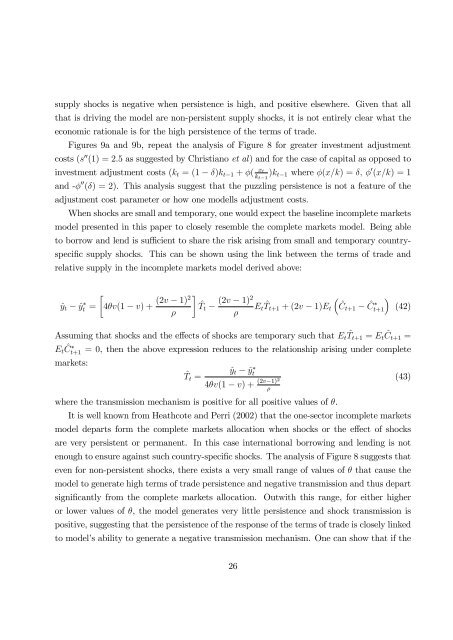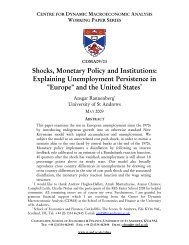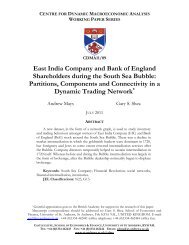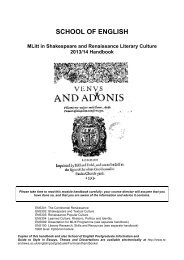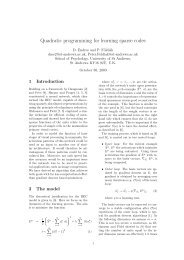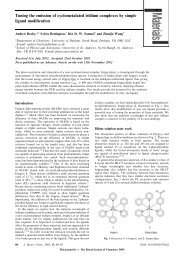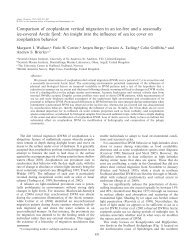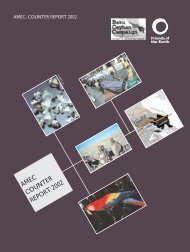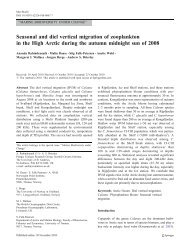Exchange rate dynamics, asset market structure and the role of the ...
Exchange rate dynamics, asset market structure and the role of the ...
Exchange rate dynamics, asset market structure and the role of the ...
Create successful ePaper yourself
Turn your PDF publications into a flip-book with our unique Google optimized e-Paper software.
supply shocks is negative when persistence is high, <strong>and</strong> positive elsewhere. Given that all<br />
that is driving <strong>the</strong> model are non-persistent supply shocks, it is not entirely clear what <strong>the</strong><br />
economic rationale is for <strong>the</strong> high persistence <strong>of</strong> <strong>the</strong> terms <strong>of</strong> trade.<br />
Figures 9a <strong>and</strong> 9b, repeat <strong>the</strong> analysis <strong>of</strong> Figure 8 for greater investment adjustment<br />
costs (s 00 (1) = 2:5 as suggested by Christiano et al) <strong>and</strong> for <strong>the</strong> case <strong>of</strong> capital as opposed to<br />
investment adjustment costs (k t = (1 )k t 1 + ( xt<br />
k t 1<br />
)k t 1 where (x=k) = ; 0 (x=k) = 1<br />
<strong>and</strong> - 00 () = 2). This analysis suggest that <strong>the</strong> puzzling persistence is not a feature <strong>of</strong> <strong>the</strong><br />
adjustment cost parameter or how one modells adjustment costs.<br />
When shocks are small <strong>and</strong> temporary, one would expect <strong>the</strong> baseline incomplete <strong>market</strong>s<br />
model presented in this paper to closely resemble <strong>the</strong> complete <strong>market</strong>s model. Being able<br />
to borrow <strong>and</strong> lend is su¢ cient to share <strong>the</strong> risk arising from small <strong>and</strong> temporary countryspeci…c<br />
supply shocks. This can be shown using <strong>the</strong> link between <strong>the</strong> terms <strong>of</strong> trade <strong>and</strong><br />
relative supply in <strong>the</strong> incomplete <strong>market</strong>s model derived above:<br />
^y t ^y t =<br />
4v(1 v) +<br />
<br />
(2v 1)2<br />
<br />
(2v 1)<br />
^T 2<br />
<br />
t E t ^Tt+1 + (2v 1)E t ^Ct+1 ^C<br />
<br />
t+1<br />
(42)<br />
Assuming that shocks <strong>and</strong> <strong>the</strong> e¤ects <strong>of</strong> shocks are temporary such that E t ^Tt+1 = E t ^Ct+1 =<br />
E t ^C t+1 = 0, <strong>the</strong>n <strong>the</strong> above expression reduces to <strong>the</strong> relationship arising under complete<br />
<strong>market</strong>s:<br />
^T t =<br />
^y t<br />
^y t<br />
4v(1 v) +<br />
(2v 1)2<br />
<br />
where <strong>the</strong> transmission mechanism is positive for all positive values <strong>of</strong> .<br />
It is well known from Heathcote <strong>and</strong> Perri (2002) that <strong>the</strong> one-sector incomplete <strong>market</strong>s<br />
model departs form <strong>the</strong> complete <strong>market</strong>s allocation when shocks or <strong>the</strong> e¤ect <strong>of</strong> shocks<br />
are very persistent or permanent. In this case international borrowing <strong>and</strong> lending is not<br />
enough to ensure against such country-speci…c shocks. The analysis <strong>of</strong> Figure 8 suggests that<br />
even for non-persistent shocks, <strong>the</strong>re exists a very small range <strong>of</strong> values <strong>of</strong> that cause <strong>the</strong><br />
model to gene<strong>rate</strong> high terms <strong>of</strong> trade persistence <strong>and</strong> negative transmission <strong>and</strong> thus depart<br />
signi…cantly from <strong>the</strong> complete <strong>market</strong>s allocation. Outwith this range, for ei<strong>the</strong>r higher<br />
or lower values <strong>of</strong> , <strong>the</strong> model gene<strong>rate</strong>s very little persistence <strong>and</strong> shock transmission is<br />
positive, suggesting that <strong>the</strong> persistence <strong>of</strong> <strong>the</strong> response <strong>of</strong> <strong>the</strong> terms <strong>of</strong> trade is closely linked<br />
to model’s ability to gene<strong>rate</strong> a negative transmission mechanism. One can show that if <strong>the</strong><br />
(43)<br />
26


